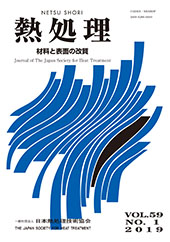
- |<
- <
- 1
- >
- >|
-
Fanhui MENG, Goro MIYAMOTO, Tadashi FURUHARA2019 Volume 59 Issue 6 Pages 336-343
Published: 2019
Released on J-STAGE: January 23, 2020
JOURNAL FREE ACCESSPure iron and Fe-M (M=Mo, Si, Mn, Cr, Al, V) binary ferritic alloys were nitrided at 843K for various times. Phase constituent, hardness distribution and growth rate of the compound layer are investigated by means of X-ray diffraction, EBSD, EPMA, 3DAP and nanoindentation. In pure iron, ε and γ’ (in the beneath of ε) are formed on the surface, and voids are formed at the outermost surface. The hardness of γ’ is higher than ferrite matrix, while void formation causes softening of compound layer. Although alloying effects on the hardness of compound layer are small, Si, V and Al additions suppress formation of voids, softening is suppressed. All the elements investigated increase growth rate of compound layers, especially that Si, V and Al additions accelerate their growth rate significantly due to the presence of excess nitrogen in compound layer. However, in the case of Al-added specimen, the growth becomes sluggish at longer nitriding time, probably because extensive precipitation of AlN precipitates in the diffusion layer.
View full abstractDownload PDF (2194K) -
Naoya TOSHIOKA, Akio NISHIMOTO2019 Volume 59 Issue 6 Pages 344-349
Published: 2019
Released on J-STAGE: January 23, 2020
JOURNAL FREE ACCESSLow carbon steel sample S15C was nitrided by active screen plasma nitriding (ASPN) and direct current plasma nitriding with screen (S-DCPN) using a chromium screen to form simultaneously chromium nitride coating/nitrogen-diffusion layer on the sample surface. The sample was placed on the sample stage in a floating potential and a cathodic potential. A chromium screen was mounted on the cathodic stage parallel to the top of the sample. Plasma nitriding treatments in a floating potential (ASPN) and a cathodic potential (S-DCPN) were performed in a nitrogen–hydrogen atmosphere with 75% N2 + 25% H2 for 120 min at 773 K and 873 K under 200 Pa. After nitriding, the nitrided microstructure was examined with a scanning electron microscope, glow discharge optical emission spectroscopy and X-ray diffraction studies. In addition, the hardness and corrosion properties were also measured. The nitrided layer formed by S-DCPN consisted of a Crconcentrated layer (~750 HV) followed by a nitrogen-diffusion layer whereas that formed by ASPN consisted of deposited layer of chromium nitrides and iron nitrides without nitrogen-diffusion layer. Corrosion resistance of the sample treated by S-DCPN was better than that of untreated sample and sample treated by ASPN.
View full abstractDownload PDF (1889K)
- |<
- <
- 1
- >
- >|